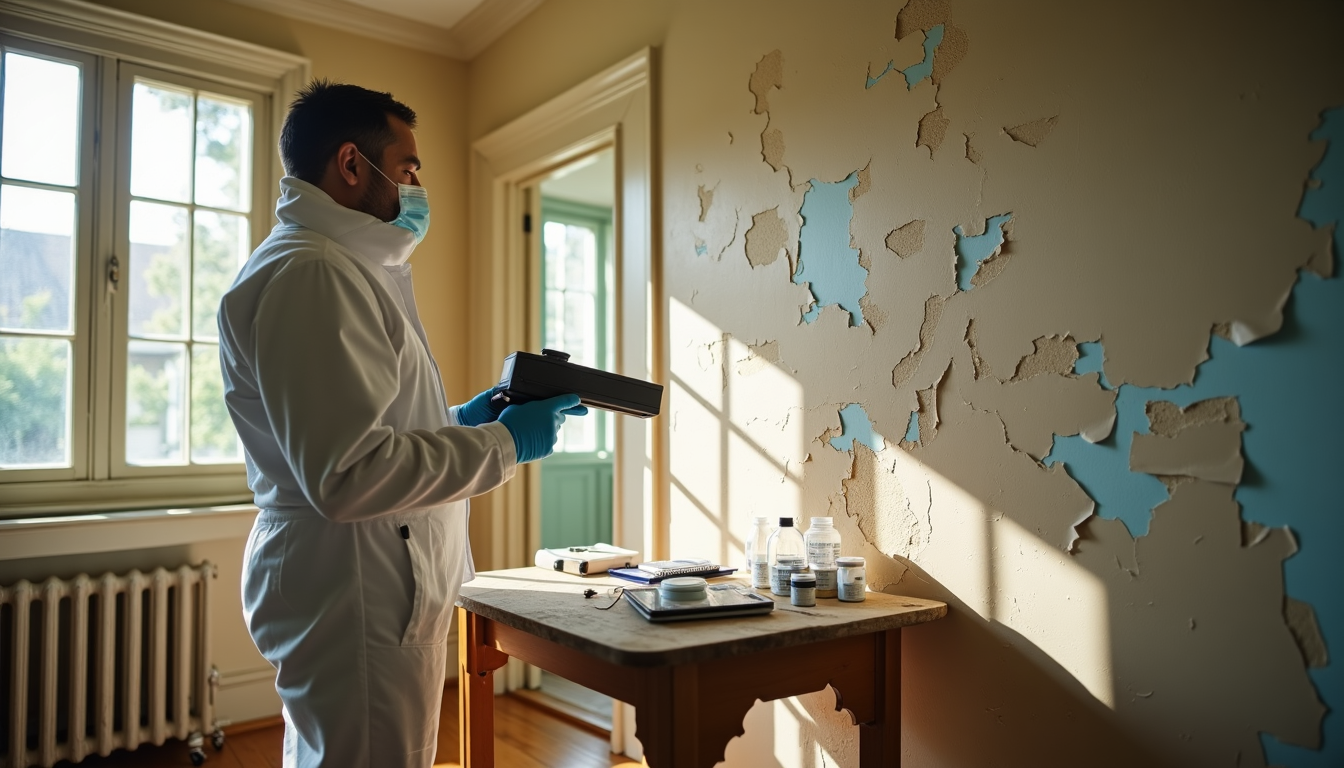Is Your Home Hiding Lead Paint? The Truth About Lead Paint Testing in 2025
Lead paint lurks in 87% of homes built before 1940, and 24% of homes built between 1960 and 1978 still contain this hidden danger. In 2025, lead paint testing plays a significant role in keeping families safe, especially when young children under 6 face serious health and behavioral risks from lead exposure.
Many homeowners feel uncertain about lead-based paint testing. This piece will help you understand your options, whether you're thinking over a professional inspection or learning about lead paint testing kits. You'll learn to identify risk factors and choose the right testing method to protect your home and family from lead paint hazards.
Why Lead Paint Testing Matters in 2025
Lead exposure threatens the health of families across America, with children under six facing the greatest risk. Lead exposure can cause permanent brain damage, behavioral issues, and lower IQ scores in children. Adults also face serious health risks including cardiovascular disease, reduced kidney function, and potential cancer.
Health risks in modern homes
The danger exists in tiny particles - lead dust remains one of the main causes of high blood lead levels in children. This hidden threat comes from old lead paint breaking down or home renovation projects. Young children have a higher risk because they crawl around and often put their hands in their mouths.
Lower-income neighborhoods and communities of color face higher risks because of:
More buildings with deteriorating lead paint in low-income areas
Past housing discrimination based on race
Few options for safe, affordable housing
Recent changes in testing regulations
Property owners must meet a vital deadline by January 2025. Local Law 123 of 2023 requires them to fix lead paint hazards in pre-1960 buildings where young children live. They also have until July 2027 to remove lead paint from doors and windows and make all floors smooth and easy to clean.
The Environmental Protection Agency has tightened its rules. Now any detectable lead dust level measured by EPA-approved labs is considered unsafe. On top of that, New York City property owners must now conduct x-ray fluorescence (XRF) testing in individual units and common spaces.
Owners have three years to complete lead paint removal when children under six move in after January 1, 2025. These stricter rules protect children and communities from lead paint's harmful effects, particularly in areas that have historically suffered from environmental inequity.
Understanding Your Home's Risk Level
You should know one vital fact when checking your home's lead paint risk: about three-quarters of houses built before 1978 have some type of lead-based paint.
Age-based risk factors
Your home's age helps predict if lead paint exists. Houses built before 1940 have an 87% chance of containing lead-based paint. Those built between 1960 and 1978 have a 24% likelihood of lead paint. Lead paint that's managed to keep its condition poses little risk, but proper identification keeps everyone safe.
Common hiding spots for lead paint
Lead-based paint shows up in high-traffic areas throughout your home. You won't see it right away because newer paint layers often cover it. Here are the places where it's most likely to be:
Window frames and sills
Door frames and thresholds
Stairways and banisters
Kitchen and bathroom walls
Exterior surfaces and porches
Cabinet doors and drawers
Signs of potential lead presence
You can spot potential lead paint by looking for specific visual clues. The paint might show an "alligator" scaling pattern or have a chalky, white appearance under newer layers. Areas with friction and impact need extra attention because they often deteriorate first.
Your home needs immediate attention if the paint peels, chips, or shows water damage. Windows and doors deserve careful inspection because they wear down from regular use. Professional lead paint testing becomes a vital step if you notice these warning signs. This helps confirm your concerns and protects your family's safety.
Professional vs DIY Testing Methods
Homeowners have two main options to test for lead-based paint: they can hire professional services or use DIY test kits. Both methods have their own benefits and drawbacks to think about.
Testing for lead based paint: Professional options
Professional lead testing uses two main methods: X-ray fluorescence (XRF) testing and laboratory analysis. XRF testing equipment measures lead content through high-energy beams and gives instant results without surface damage. The original method of XRF testing remains the gold standard for lead paint detection. It can measure lead content as little as 0.5 milligrams per square centimeter.
Laboratory analysis is another professional option that uses atomic absorption spectrophotometry or inductively coupled plasma testing on paint chip samples. This method gives the most accurate results and works best for legal documentation or property transactions.
Why You Need Professional Lead Paint Testing
While home testing kits are available, they often lack accuracy and may provide false negatives, giving you a false sense of security. Professional lead paint testing, on the other hand, ensures precise and legally compliant results, giving you the certainty needed to protect your family and home.
Lead paint testing kit: Pros and cons
DIY test kits are more available but come with some limitations. The EPA has approved only three lead test kits: 3M LeadCheck, D-Lead, and the State of Massachusetts Test Kit. These kits keep false negative rates at 5% or less. Experts suggest testing the same area several times to get better accuracy.
Advantages of DIY kits:
You get results right away
They're affordable for small areas
You can use them easily at home
Limitations:
They can't detect lead in deeper paint layers
Results might be wrong
You can't measure exact lead levels.
Steps to Get Your Home Tested
Lead paint testing in your home requires smart decisions about testing methods and proper preparation. The EPA strongly recommends you hire a certified professional inspector or risk assessor to get reliable results.
Choosing a testing method
Homeowners can choose between two main testing options: laboratory analysis or professional inspection. Laboratory testing costs USD 25.00 to USD 50.00 per sample and delivers results within 24-48 hours. Professional inspections take 2-4 hours to complete based on your home's size.
Preparing your home
Your home needs these key preparation steps:
Clean all surfaces with a HEPA vacuum
Remove debris from floors and window sills
Keep all paint intact without peeling or chipping
Make sure all rooms, closets, and storage areas are accessible
What to expect during testing
A certified inspector will evaluate your property systematically. They start by documenting your home's condition and collecting samples. The inspection covers both interior and exterior components like walls, windows, doors, and trim work.
You'll receive a detailed report within 10 working days after the inspection. This report has vital information about testing methods, specific test locations, and full results of the analysis. Paint chip sampling must include all layers to ensure accurate test results.
Why You Need Professional Lead Paint Testing
While home testing kits are available, they often lack accuracy and may provide false negatives, giving you a false sense of security. Professional lead paint testing, on the other hand, ensures precise and legally compliant results, giving you the certainty needed to protect your family and home.
Why Choose ELI NYC for Lead Paint Testing?
At ELI NYC, we understand that dealing with lead concerns can be stressful, which is why we provide a seamless, customer-focused experience. Here’s why our clients trust us:
✅ Competitive Pricing – We offer some of the best rates in NYC without compromising quality.
✅ Industry Expertise – Our team has years of experience handling lead testing, abatement, and compliance issues.
✅ Warm & Friendly Service – Unlike other providers, we genuinely care about your home and well-being, ensuring a stress-free, guided process from start to finish.
✅ Fast & Accurate Results – Our testing methods meet all EPA and NYC compliance regulations, giving you results you can rely on.
Conclusion
Lead paint testing is a vital safety measure, especially when we know how systemic these problems are in older homes. Your well-kept lead paint might look harmless, but deterioration and renovation create serious risks that make testing crucial to protect your family.
Professional testing delivers the most reliable results through XRF technology and lab analysis, though it costs more. DIY test kits work great for initial screening, but they're nowhere near suitable to get a detailed evaluation of your home.
The new 2025 regulations highlight why proper lead paint detection and cleanup matter more than ever. Homeowners need to take action quickly, particularly if their property was built before 1978 or if young children under six live there.
Safety should be your priority when you deal with potential lead hazards. Professional testing helps prevent exposure risks instead of waiting for paint to visibly deteriorate. Note that lead paint's impact goes beyond individual families and affects whole communities. This makes proper detection and management of everyone's shared duty to create safer and healthier homes.
Take Action Today – Protect Your Home & Family
Don’t wait until lead exposure becomes a health hazard! Schedule a professional lead paint test with ELI NYC today and ensure your home is safe
Your family’s health is too important to leave to chance—let ELI NYC provide you with the trusted, accurate, and affordable lead testing you deserve.

